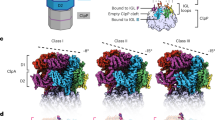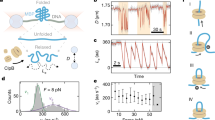Abstract
The degradation of cytoplasmic proteins is an ATP-dependent process1. Substrates are targeted to a single soluble protease, the 26S proteasome2,3, in eukaryotes and to a number of unrelated proteases in prokaryotes4,5. A surprising link emerged with the discovery of the ATP-dependent protease HslVU (heat shock locus VU)6,7,8 in Escherichia coli. Its protease component HslV shares ∼20% sequence similarity6 and a conserved fold9 with 20S proteasome β-subunits. HslU is a member of the Hsp100 (Clp) family of ATPases. Here we report the crystal structures of free HslU and an 820,000 relative molecular mass complex of HslU and HslV–the first structure of a complete set of components of an ATP-dependent protease. HslV and HslU display sixfold symmetry, ruling out mechanisms of protease activation that require a symmetry mismatch between the two components. Instead, there is conformational flexibility and domain motion in HslU and a localized order–disorder transition in HslV. Individual subunits of HslU contain two globular domains in relative orientations that correlate with nucleotide bound and unbound states. They are surprisingly similar to their counterparts in N-ethylmaleimide-sensitive fusion protein10,11, the prototype of an AAA-ATPase. A third, mostly α-helical domain in HslU mediates the contact with HslV and may be the structural equivalent of the amino-terminal domains in proteasomal AAA-ATPases.
This is a preview of subscription content, access via your institution
Access options
Subscribe to this journal
Receive 51 print issues and online access
$199.00 per year
only $3.90 per issue
Buy this article
- Purchase on Springer Link
- Instant access to full article PDF
Prices may be subject to local taxes which are calculated during checkout





Similar content being viewed by others
References
Goldberg, A. L. & St. John, A. C. Intracellular protein degradation in mammalian and bacterial cells: part 2. Annu. Rev. Biochem. 45, 747–803 (1976).
Hershko, A. & Ciechanover, A. The ubiquitin system for protein degradation. Annu. Rev. Biochem. 61, 761 –807 (1992).
Hershko, A. & Ciechanover, A. The ubiquitin system. Annu. Rev. Biochem. 67, 425–479 (1998).
Maurizi, M. R. Proteases and protein degradation in Escherichia coli. Experientia 48, 178–201 (1992).
Gottesman, S., Wickner, S. & Maurizi, M. R. Protein quality control: triage by chaperones and proteases. Genes Dev. 11, 815– 823 (1997).
Chuang, S. E., Burland, V., Plunkett, G., Daniels, D. L. & Blattner, F. R. Sequence analysis of four new heat shock genes constituting the hslu and hslv operons in Escherichia coli. Gene 134, 1–6 (1993).
Rohrwild, M. et al. HslV-HslU: a novel ATP-dependent protease complex in Escherichia coli related to the eukaryotic proteasome. Proc. Natl Acad. Sci. USA 93, 5808–5813 ( 1996).
Missiakis, D., Schwager, F., Betton, J. -M., Georgopoulos, C. & Raina, S. Identification and characterizaton of HslV HslU (ClpQ ClpY) proteins involved in overall proteolysis of misfolded proteins in Escherichia coli. EMBO J. 15, 6899–6909 (1996).
Bochtler, M., Ditzel, L., Groll, M. & Huber, R. Crystal structure of heat shock locus V (HslV) from Escherichia coli. Proc. Natl Acad. Sci. USA 94, 6070–6074 (1997).
Lenzen, C. U., Steinmann, D., Whiteheart, S. W. & Weis, W. I. Crystal structure of the hexamerization domain of N-ethylmaleimide-sensitive fusion protein. Cell 94, 525– 536 (1998).
Yu, R. C., Hanson, P. I., Jahn, R. & Brünger, A. T. Structure of the ATP-dependent oligomerization domain of the N-ethylmaleimide sensitive factor complexed with ATP. Nature Struct. Biol. 5, 803–811 (1998).
Huang, H. -C. & Goldberg, A. L. Proteolytic activity of the ATP-dependent protease HslVU can be uncoupled from ATP-hydrolysis. J. Biol. Chem. 272, 21364–21372 ( 1997).
Neuwald, A. F., Aravind, L., Spouge, J. L. & Koonin, E. V. AAA+: a class of chaperone-like ATPases associated with the assembly, operation and disassembly of protein complexes. Genome Res. 9, 27– 43 (1999).
Feng, H. P. & Gierasch, L. M. Molecular chaperones: clamps for the Clps? Curr. Biol. 8, 464– 467 (1998).
Traut, T. W. The functions and consensus motifs of nine types of peptide segments that form different types of nucleotide binding sites. Eur. J. Biochem. 222, 9–19 ( 1994).
Saraste, M., Sibbald, P. R. & Wittinghofer, A. The P-loop—a common motif in ATP—and GTP-binding proteins. Trends Biochem. 15, 430– 434 (1990).
Smith, C. A. & Rayment, I. Active site comparisons highlight structural similarities between myosin and other P-loop proteins. Biophys. J. 70, 1590–1602 (1996).
Rohrwild, M. et al. The ATP-dependent HslVU protease from Escherichia coli is a four-ring structure resembling the proteasome. Nature Struct. Biol 4, 133–139 (1997).
Schirmer, E. C., Glover, J. R., Singer, M. A. & Lindquist, S. Hsp100/Clp proteins: a common mechanism explains diverse functions. Trends Biochem. Sci. 21, 289–296 (1996).
Karata, K., Inagawa, T., Wilkinson, A. J., Tatsuta, T. & Ogura, T. Dissecting the role of a conserved motif (the second region of homology) in the AAA family of ATPases. J. Biol. Chem. 274, 26225–26232 (1999).
Levchenko, I., Smith, C. K., Walsh, N. P., Sauer, R. T. & Baker, T. A. PDZ-like domains mediate binding specificity in the Clp/Hsp100 family of chaperone. Cell 91, 939–947 (1997).
Smith, C. K., Baker, T. A. & Sauer, R. T. Lon and Clp family proteases and chaperones share homologous substrate-recognition domains. Proc. Natl Acad. Sci. 96, 6678–6682 (1999).
Weber-Ban, E. U., Reid, B. G., Miranker, A. D. & Horwich, A. L. Global unfolding of a substrate protein by the Hsp100 chaperone ClpA. Nature 401, 90–93 ( 1999).
Löwe, J. et al. Crystal structure of the 20S proteasome from the archaeon T. acidophilum at 3. 4 Å resolution. Science 268, 533–539 (1995).
Groll, M. et al. Structure of 20S proteasome from yeast at 2.4 Å resolution. Nature 386, 463–471 (1997).
Knowlton, J. R. et al. Structure of the proteasome activator REGα (PA28α). Nature 390, 639–643 (1997).
Glickman, M. H. et al. A subcomplex of the proteasome regulatory particle required for ubiquitin-conjugate degradation and related to the COP9-signalosome and elF3. Cell 94, 615–623 (1998).
Project, C. C. C. The CCP4 suite: programs for protein crystallography. Acta Cryst. D 50, 760–763 ( 1994).
Jones, A. T. A graphics model building and refinement system for macromolecules. J. Appl. Crystallogr. 11, 268–272 (1978).
Brünger, A. T. et al. Crystallography and NMR system: a new software suite for macromolecular structure determination. Acta Cryst. D 54, 905–921 (1998).
Acknowledgements
We thank P. Zwickl for 14C-labelled casein, for his help with the protein degradation assay and for essential discussions; S. Grazulis for sharing PDB-scripts M. Boicu for DNA sequencing; and R. Engh for critically reading the manuscript. The financial support of the Deutsche Forschungsgemeinschaft and of the Human Frontier Science Program is acknowledged.
Author information
Authors and Affiliations
Corresponding author
Rights and permissions
About this article
Cite this article
Bochtler, M., Hartmann, C., Song, H. et al. The structures of HslU and the ATP-dependent protease HslU–HslV . Nature 403, 800–805 (2000). https://doi.org/10.1038/35001629
Received:
Accepted:
Issue Date:
DOI: https://doi.org/10.1038/35001629
This article is cited by
-
Structural-genetic insight and optimization of protease production from a novel strain of Aeromonas veronii CMF, a gut isolate of Chrysomya megacephala
Archives of Microbiology (2021)
-
ClpAP protease is a universal factor that activates the parDE toxin-antitoxin system from a broad host range RK2 plasmid
Scientific Reports (2018)
-
Probiotic Escherichia coli inhibits biofilm formation of pathogenic E. coli via extracellular activity of DegP
Scientific Reports (2018)
-
ACCORD: an assessment tool to determine the orientation of homodimeric coiled-coils
Scientific Reports (2017)
-
Assessing heterogeneity in oligomeric AAA+ machines
Cellular and Molecular Life Sciences (2017)
Comments
By submitting a comment you agree to abide by our Terms and Community Guidelines. If you find something abusive or that does not comply with our terms or guidelines please flag it as inappropriate.



